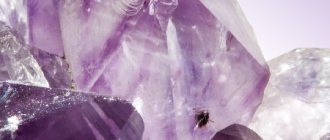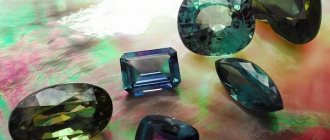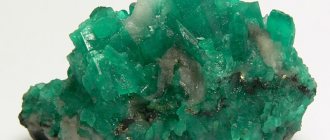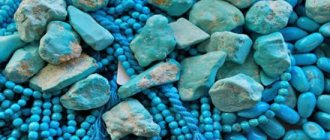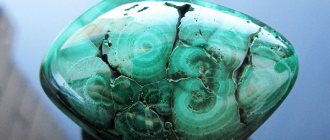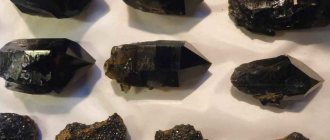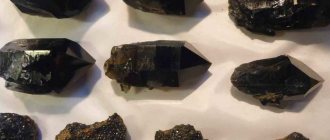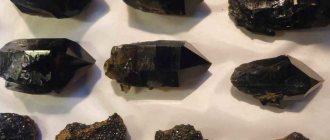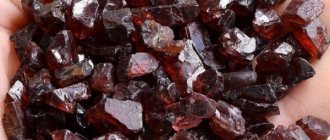What does a gem look like?
To analyze samples, you should know what the standard is, that is, natural garnet.
The gem looks like the fruit of a southern fruit. Dark purple, that is, a shade of garnet, is considered classic. There are other colors, not just blue. They are created by impurities of manganese, calcium, chromium, iron, and magnesium.
Pomegranate substitutes
Most often, glass or plastic is offered instead of mineral. A technology has been developed for producing a special type of garnet glass with a color that imitates natural glass. Due to the low cost of garnet, stones to imitate it are rarely used.
It is more difficult to distinguish garnets from fakes if they are artificially grown stones such as cubic zirconia. Jewelry with several stones (bracelet or beads) requires attention. In them, a real garnet can coexist with fakes.
Magic properties
The mineral garnet is considered the stone of lovers. It denotes loyalty and trust. Even in ancient times, girls seeking to find their betrothed carried with them a small amulet with a piece of red stone.
People believed that the gem ignites the flame of love. A gift in the form of a decoration with a pomegranate symbolized sincere feelings and fidelity. People who believe in the magic of the stone claim that this carbuncle can increase libido and balance sexual energy.
Pyropes help active and sociable individuals. But apathetic and lazy people are not advised to wear it, as it can cause harm due to its strong energy.
Pomegranate is suitable for creative people , for example, sculptors, writers, artists, composers. The mineral will fill them with energy, which will have a positive effect on their future activities. The gem will also be useful for entrepreneurs. The amulet will help attract new partners and lead to financial success.
Ancient peoples believed that the carbuncle helped overcome depression and prevent suicide. The mineral is able to revitalize, cleanse and balance the energy in a person who has given up. The amulet gives him peace and, if necessary, passion.
In case of emotional disharmony, pomegranate has a calming effect on a person. The stone instills hope in him and strengthens the instinct of self-preservation, which is especially necessary in crisis situations.
Garnet, which is still considered a powerful magical stone, is not recommended to be worn if its owner feels a loss of strength and deterioration in condition. Experts recommend purchasing a mineral that has not yet had owners. This way you will achieve energetic compatibility with the stone. If a pomegranate was inherited by a person, then it should first be cleaned under running water, and then used as a talisman decoration.
How to recognize a fake
The color scheme of the stone creates scope for those who love counterfeiting. There are simple ways to determine the origin of a stone at home.
Visual analysis
The size, color, and transparency of the sample are assessed. Examine a pebble in the light. A magnifying glass will come in handy.
- Size. A nugget pomegranate has the dimensions of a grain of the fruit of the same name. After processing they are even smaller. If the crystals are larger, it is a fake. Especially green stones. They are rare and prohibitively expensive. Bypassing the counters, they end up in private, corporate or state treasuries.
- Coloring. The garnet is fragmentary. Even elite jewelry samples have gradations and zoning of color and different densities. It is possible for one stone to have shades. Fake specimens are painted evenly.
- Inclusions. Pure specimens are rare, expensive, and inaccessible. Unlike an artificial one, a real gem has small inclusions. But not gas bubbles - they only exist in glass.
- Shine. Even when cut, the natural gem has a muted, matte, velvety shine. Synthetic is dazzling.
- Play of light. Garnet transmits light unevenly, refracting at the edges. Visually it looks like an internal play of light. This is not possible for counterfeiting.
It is unreasonable to shell out a lot of money for a large shiny pebble without “foreign objects” or with bubbles inside.
Mechanical impact
Determination methods are based on the physical properties of the mineral.
- Scratching. The hardness of garnet is high. It easily scratches glass or plastic. If there is no trace left or the sample being tested is damaged as a result of scratching, it is not a garnet, but plastic or a cheap gem.
- Heating. Garnet is, although precious, a stone. Glass or plastic heats up in your hands faster than it does. If the sample remains cool after a few minutes, it is a mineral. It's easy to feel the difference by holding the sample and the glass at the same time.
- Magnetism. Garnet has the property of being magnetized. The experiment is carried out on highly sensitive (electronic or carat) scales. For the purity of the experiment, their steel surface is insulated. That is, cork, plastic or other insulating material is placed on the scales, and the sample being tested is placed on them. The readings are recorded when the pomegranate is at rest. Then they pass a magnet over it (about 1 cm) and look at the numbers. If the weight has decreased, it is a garnet - the pebble seems to be pulled by a magnet.
- Electrification. When rubbed, the stone becomes electrified. If you rub a pomegranate on wool, it will attract pieces of paper, hair, straws, and fluff.
The latter experience will help distinguish a natural mineral from a man-made one, but not from glass. It is also electrified.
Artificial pomegranate
Laboratory-grown stones are larger, purer than natural ones, and evenly colored. Hard, cut well. Treated crystals play in the light. Recognized by the following characteristics:
- arcs, rings or straight segments (crystal growth lines);
- are not magnetized;
- are not electrified.
Jewelry stones have been grown around the world since the late 1960s. The technology is complex, so prices are comparable to its natural counterpart. Since 1973, in the USSR, jewelry was supplied with artificial garnets in pink, pale purple, yellow shades, colorless and cubic zirconia, and two years later - with emeralds. So inherited Soviet-era jewelry does not always contain natural stones.
Pomegranate: description, history of origin
The amazingly beautiful gem was used for decoration back in Ancient Greece, Persia and Rome. It had several names: the Greeks called it “anthrax,” translated as “hot stone,” and the Romans called the mineral “carbuncle.” In Russia, during the heyday of jewelry, it was known as “venisa” and “bechet.” The stone owes its modern name to the alchemist Albert Magnus, who in 1270 called it “garnet.” This was a good choice, because the name literally translates as “grain-like.”
The stone entered Europe only in the 17th century, and at the beginning of the 19th century there was an absolutely amazing discovery. It turned out that garnet has several varieties - then this name began to mean a whole group of gems.
Garnet is a group of minerals united by a characteristic feature - a crystal lattice with square edges. They belong to the class of silicates and have the following properties:
- High strength coefficient - hardness on the Mohs scale - 6.5-7.5 points;
- Resistance to chemical and thermal influences;
Garnets can shimmer in the light, the shade changes along a gradient. Therefore, large specimens are especially valued, demonstrating all the beauty of the stone.
Garnet and ruby
An inexpensive gem is used as an imitation of first-row stones. Ruby “suffers” the most.
It is not difficult to distinguish a semi-precious stone from a ruby. The ruby is not magnetized and shines like a diamond in daylight. The shine of garnet is soft and velvety. It's more of a flicker.
It is better to buy expensive jewelry in trusted stores with quality certificates. The origin of a pebble received as an inheritance, given as a gift, or found is checked. The described methods allow you to do this at home. If you have any doubts about the “pedigree” of a gem, it’s worth investing in a professional examination.
Place of Birth
In the jewelry business, the highest demand is for jewelry of medium cost, so common garnet mining sites are geared toward obtaining inexpensive stones. Their territory extends over long distances - Karelia, Alaska, Brazil and Madagascar. More expensive and high-quality gems are mined in Chukotka; these deposits are well known.
The rarest specimens of garnet are mined in Madagascar and Tanzania. Blue garnets are considered unique because they can change color depending on the lighting.
Compatibility with zodiac signs
Pomegranate helps purposeful and assertive people, improves their interaction with other people. The gem is ideal for Capricorns, revealing their potential and charisma. It is especially recommended for reserved individuals who have problems expressing emotions.
Scorpios and Virgos will also feel the positive influence of pomegranate, but each in their own way. The former will become more restrained and reasonable, and will succeed in love affairs. Pedantic Virgos will feel more relaxed and will be able to harmoniously combine work and personal life.
Aquarians can only wear garnet jewelry if it has a specific purpose. Otherwise, the stone will have a negative effect on them, suppressing creativity. Hot-tempered Sagittarius under the influence of pomegranate will become softer and wiser, and will be capable of deep feelings.
Changeable Gemini and Libra will become more confident in their decisions, their view of the world will become more optimistic. Aries will be able to overcome anxious thoughts and focus on the positive aspects of life.
It is not recommended to wear garnet for Leo, Cancer and Pisces. Leos should treat him with caution; their natural self-confidence can turn into selfishness.
Varieties
The crystal structure of garnets is identical, but the chemical composition may differ noticeably. It is this that is the reason for the diversity of this gem. Jewelers distinguish the following varieties of garnet:
- Uvarovite. It is a rare variation of pomegranate, distinguished by its bright green hue.
- Grossular. Usually has a yellow or green color.
- Almadin. A popular type of pomegranate, it has a classic red color, sometimes shimmering with brown and crimson shades.
- Demantoid is a very expensive and rare green garnet.
- Spessartine. It is distinguished by its uniform golden-orange color among rare gems. Usually it has a pink tint.
- Andradite. An unusual variety of pomegranate, it comes in brown, yellow and crimson colors.
- Melanitis. Black garnet is valued for its medicinal properties.
- Majorite. The rarest purple garnet.
The stone most often seen on jewelry store shelves is pyrope; it is also called “red garnet.” Some specimens may have an orange or purple sheen. The price of a stone directly depends on its color, because it indicates the scale of its distribution.
Interesting facts about the stone
- In the Czech Republic, pomegranate is considered a symbol of patriotism.
- “Fire stone” was the name of the gem in Mongolia. It was believed that it would bring wealth to the owner.
- Jewish legend says that Noah placed a pomegranate on the mast of the ark to light the way.
- In books of magic, the pomegranate is called dragon's blood, as well as ant's blood. The latter is due to the fact that in North America, red crystals are found in anthills.
- In Persia, the crystal was considered the stone of kings.
- In Italy, garnet is considered the stone of honesty. A beautiful legend says that the thief who stole a garnet necklace was left with nothing: after the end of the chase, the stone faded and turned gray.
Price
The price of garnet depends on certain factors - the size of the stone, variety and cut. The price of the most common gemstone, pyrope, varies from 500 to 2000 rubles per carat. The better the cut, the higher the cost. Almadine is a variety with a blue sheen and has a price of 1,900 rubles per carat and above. The figures for rhodolite are approximately the same; the numbers may vary depending on the type of decoration.
Spessartines, which are considered very rare in Russia, are much more expensive. The price for a finished product weighing 3-4 carats can reach 35-40 thousand rubles. Orange crystals are most valued, while brown ones are considered simpler.
Chemical composition and physical properties
Garnets are silicates with a high content of magnesium, calcium and iron. Depending on the chemical composition, their individual types are classified as both precious and semi-precious, ornamental stones. The general formula of all these minerals looks like this: Mg+Fe+Mn+ +Ca+3Al2[SiO4]3.
At the same time, each subspecies of pomegranate has its own chemical composition. It is the concentration of certain elements that determine the shades of garnet, density and shine.
Despite the number of varieties of stone, its properties in all “varieties” remain approximately the same.
Garnet molecules have a cubic lattice and form either rhombododecahedrons (closed compounds of 12 faces) or tetrahoptrioctahedra (24 faces).
Scientists divide all pomegranates into two main subspecies:
- Pyralspite, which is dominated by iron, magnesium and manganese; form a 12-sided crystal lattice; This is exactly the structure of pyrope, spessarine and almadine.
- Ugrandites, with a high calcium content (as, for example, in uvarovites, grossulars and andradites). The molecules of these gems are formed into tetrahoptrioctahedra.
The hardness of these gemstones ranges on the ten-point Mohs scale from 6.5 (like hessonite) to 7.5 (like pyrite and almandine). Garnet can be easily polished with diamond, but if you run it across glass, it leaves a shallow scratch.
At the same time, it is quite fragile and easily breaks under a strong impact. So processing it is not such a simple matter.
The density of this mineral is low: on average from 3.47 to 3.83 g/cm3.
The surface of the garnet is smooth to the touch, glassy. But the edges of the break, on the contrary, are uneven and rough.
In nature, this gem is found in medium-sized druses. These stones are not large. The largest garnet, a fire pyrope the size of a pigeon's egg, was discovered in Germany and weighed 633 carats.
Jewelry with stone
A piece of pomegranate not inserted into the frame is suitable as a talisman. It can be beautifully polished and hidden in a pocket - this option is suitable for men who do not want to wear jewelry. Real garnet looks luxurious in large specimens, highlighting its soft radiance and gradient of shades.
A garnet necklace will add nobility to your figure and will be a wonderful addition to an evening outfit. A large pendant in a gold frame also looks amazing and is more suitable for mature women. Inlaid with silver, surrounded by shining cubic zirconia, the gem will perfectly complement the image of a young girl.
Rings with garnet are a rare thing; they are a complete decoration; they should not be worn with other rings. Small garnets are often set in silver; this solution looks good on a narrow hand.
Earrings with noble crystal come in a variety of shapes, from studs to dangles. The former will decorate a casual look, the latter – an evening look, favorably highlighting a formal outfit.
